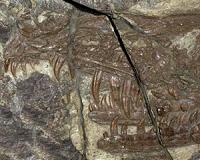| . |  |
. |
Washington DC (SPX) Jan 08, 2010 For the last 20 years, the best models of planet formation-or how planets grow from dust in a gas disk-have contradicted the very existence of Earth. These models assumed locally constant temperatures within a disk, and the planets plunge into the Sun. Now, new simulations from researchers at the American Museum of Natural History and the University of Cambridge show that variations in temperature can lead to regions of outward and inward migration that safely trap planets on orbits. When the protoplanetary disk begins to dissipate, planets are left behind, safe from impact with their parent star. The results of this research are being presented this week at the 2010 meeting of the American Astronomical Society in Washington, D.C. "We are trying to understand how planets interact with the gas disks from which they form as the disk evolves over its lifetime," says Mordecai-Mark Mac Low, Curator of Astrophysics and Division Chair of Physical Sciences at the Museum. "We show that the planetoids from which the Earth formed can survive their immersion in the gas disk without falling into the Sun." During the birth of a star, a disk of gas and dust forms. The midplane of this dusty disk is opaque and cannot quickly cool by radiating heat to outer space. Until recently, no one has included temperature variation in models of planet formation. Co-author Sijme-Jan Paardekooper of the University of Cambridge ran groundbreaking new simulations like that most recently published online. His work shows that the direction of migration of low-mass planets in disks depends on the detailed temperature structure of the disk. This key insight lays the groundwork for the current work. The American Astronomical Society presentation incorporates the results of Paardekooper's local models into the long-term evolution of the temperature and density structure of a protoplanetary disk. The result of the simulation is that, over the lifetime of a disk, planets get trapped in orbits between regions of inward and outward migration. The orbits slowly move inward as the disk dissipates. Once the gas densities drop low enough for the planets to no longer be influenced by disk, the planets are dropped into an orbit similar to the orbits of planets around the Sun. The radius of the orbit at which a planet is released depends on its mass. "We used a one-dimensional model for this project," says co-author Wladimir Lyra, a postdoctoral researcher in the Department of Astrophysics at the Museum. "Three dimensional models are so computationally expensive that we could only follow the evolution of disks for about 100 orbits-about 1,000 years. We want to see what happens over the entire multimillion year lifetime of a disk."
Share This Article With Planet Earth
Related Links American Museum of Natural History Explore The Early Earth at TerraDaily.com
 Poisonous Prehistoric Raptor Discovered
Poisonous Prehistoric Raptor DiscoveredLawrence KS (SPX) Jan 05, 2010 A group of University of Kansas researchers working with Chinese colleagues have discovered a venomous, birdlike raptor that thrived some 128 million years ago in China. This is the first report of venom in the lineage that leads to modern birds. "This thing is a venomous bird for all intents and purposes," said Larry Martin, KU professor and curator of vertebrate paleontology at the Natur ... read more |
|
| The content herein, unless otherwise known to be public domain, are Copyright 1995-2009 - SpaceDaily. AFP and UPI Wire Stories are copyright Agence France-Presse and United Press International. ESA Portal Reports are copyright European Space Agency. All NASA sourced material is public domain. Additional copyrights may apply in whole or part to other bona fide parties. Advertising does not imply endorsement,agreement or approval of any opinions, statements or information provided by SpaceDaily on any Web page published or hosted by SpaceDaily. Privacy Statement |